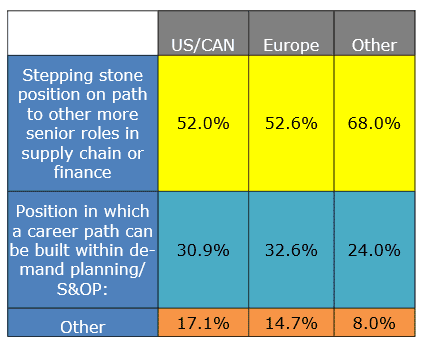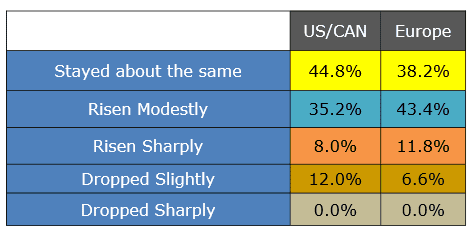|
Is there any more mysterious role in the supply chain than that of the demand planner?
Why do I say this? For a couple of reasons, I submit.
First, as I have heard many companies say, the numbers a demand planner cranks out in terms of forecasts can often commit a company to millions of dollars in inventory or capacity, yet the position is often not treated with a level of respect or analysis commensurate with that responsibility and consequence.
Gilmore Says: |
 Clearly in the consumer goods and retail sectors, as we move to forecasting each SKU at a store level, the number of DFUs per planner will explode. Clearly in the consumer goods and retail sectors, as we move to forecasting each SKU at a store level, the number of DFUs per planner will explode.

Click Here to See
Reader Feedback |
Relatedly, the type of person hired for demand planning and how that role fits into a career path is quite varied. I was at meeting two year ago where this very topic was discussed by a group of consumer goods and retail companies, and the practices in this regard were all over the map.
For example, some companies relied heavily on new hires out of college to fill junior demand planning roles, a position for which if a demand planner was any good was just a stop on a journey to something better in the supply chain.
Others mostly hired experienced demand planners from other companies, and someone could build a nice career within the demand planning team itself. And every combination in between.
Another topic is how demand planners interact with the rest of the organization. At the recent CSCMP conference, Tony Nikolai of Whirlpool gave an excellent presentation on "getting the politics out of Sales and Operations Planning," which included a process and a culture that was committed to not letting internal pressures affect the initial forecasts from the core demand planners.
Whirlpool insists on unvarnished numbers to start the process. More senior managers would then work these numbers with the business to develop a consensus (actually in Whirlpool's case, more of a range from low to high), but it had to start with the untainted facts.
So with that, I am pleased to share some of the results from our recent benchmark survey on practices and trends on the role of demand planner. I am not sure if there has ever been a study quite like this one. You can download the full report here: Demand Planner Benchmark Study 2013.
I want to thank supply chain planning software provider ToolsGroup for sponsoring this work. ToolsGroup did that really just to help move the industry's understanding of this under-studied topic forward, and I appreciate that.
We had more than 300 respondents from around the globe, led primarily by responses from US companies but a strong showing from Europe, Australia and other developed markets as well, and then a smaller response from developing economies. So for most of the data, we broke it into North America (meaning the U
S and Canada) and Europe (meaning most of Europe plus a few other countries), and in a few cases "Others" as well.
So how about the question of whether a career can be built as a demand planner or not? As can be seen below, for just over half of North American and US companies, demand planning is usually just a stepping stone to other roles in supply chain or finance.
Demand Planner Career Path at Respondent's Company

Just under one-third of respondents in both markets said a nice career could be built in the demand planning area alone, with responses in the mid-teen percentages saying "other" (which mostly meant "it depends".)
Is the workload in terms of SKUs or DFUs (demand forecasting units - say a product at a location, such as a distribution center) rising for demand planners? The general consensus in the industry is that it is, and our data mostly supports that, as can be seen below, About 35% and 43% of US/Canadian and Euro companies, respectively, say the number of DFUs that demand planners are managing has risen modestly over the past few years, and another 8% and 12% say that number has risen sharply.
Number of DFUs Per Demand Planner Rising Modestly

One question is whether this is in part the result of more automation from demand planning tools (allowing the system to do more of the work rather than the demand planner) or whether the reduction in relative demand planner headcount has forced greater use of automation to keep up. I believe it is a little of both. But clearly in the consumer goods and retail sectors, as we move to forecasting each SKU at a store level, the number of DFUs per planner will explode, requiring much more use of automation and then mostly handling by exception.
Finally, how do companies see their demand planning capabilities overall? The results show something pretty close to a bell curve, with right around 44% in NA and Europe saying their capabilities are average, with around 34% and 38%, respectively, believing they were above average or excellent, though not many claimed excellent status in either region.
How Effective are Demand Planning Processes and Results?

Ok, that's it. More in the full benchmark report.
On another quick note, we've now had more than 100 requests for our 50 Years of Supply Chain Progress timeline video, and managed to send most of those out. Still happy to send you one if you are interested. Send us a note at the Feedback button below.
Do you agree that demand planners are often under appreciated? Any reaction to these data points in the study? Let us know your thoughts at the Feedback section below.
|